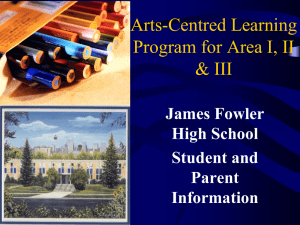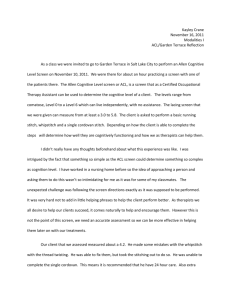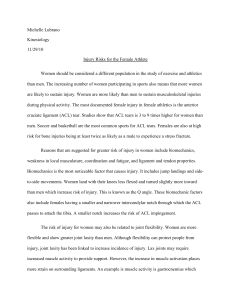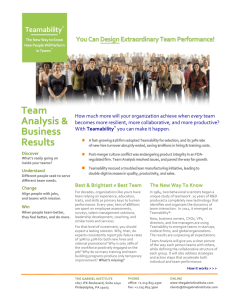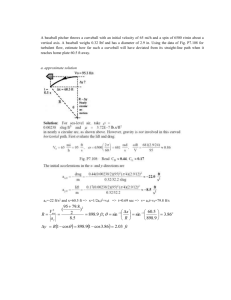Summary of Purdue Engineering Self
advertisement
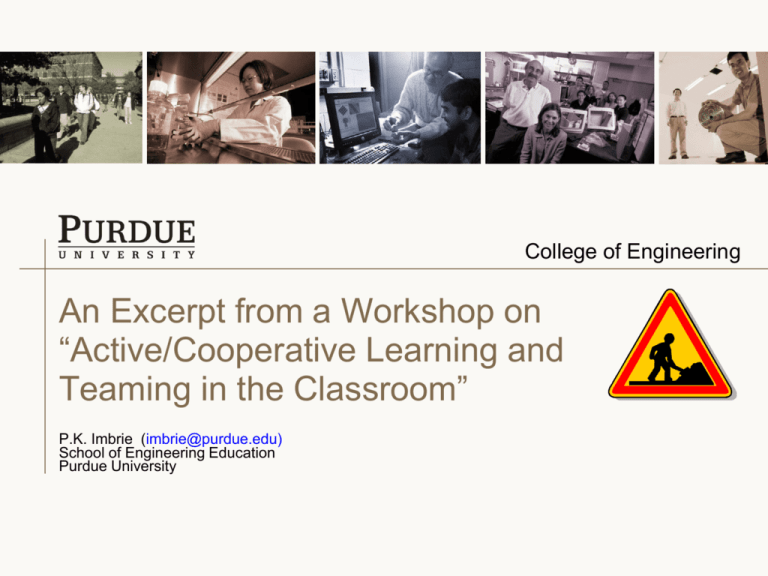
College of Engineering An Excerpt from a Workshop on “Active/Cooperative Learning and Teaming in the Classroom” P.K. Imbrie (imbrie@purdue.edu) School of Engineering Education Purdue University Frequently Asked Questions Do you have any “real” proof that this stuff works? Using ACL & teaming in the classroom means I will not be able to cover all the material I have to in a given semester. How can I do ACL & teaming and still teach what I have to? This is probably OK for intro or discussion type classes, but in difficult courses I can’t see how this will really work. How can I do this in a course were there is a lot of technical material? ACL & teaming probably works fine for small classes, but is it really appropriate for large lecture section environments Engineering Education FAQ 1: Do you have any “real” proof that this stuff works? CC Traditional FC MBT Active/Collaborative FCI 0 20 40 60 80 Passive/Traditional Posttest % Texas A&M University Foundation Coalition Integrated Freshman Pilot Program Richard Hake Dept. of Physics, Indiana Univ. Journal of Physics Engineering Education FAQ 2: Using ACL & teaming in the classroom means I will not be able to cover all the material I have to in a given semester. How can I do ACL teaming and still teach what I have to? › What students learn is generally less than what we teach…..Fact of Life according to Rich Felder, North Carolina State University › Lecturing may be the most time efficient delivery mechanism, but generally does little to impart conceptual understanding. › Changing from a reactive learning environment to one which is proactive enables you to cover more material. Engineering Education FAQ 3: This is probably OK for intro or discussion type classes, but in difficult courses I can’t see how this will really work. How can I do this in a course were there is a lot of technical material? › These methods are independent of the subject mater being taught. › What students learn is generally less than what we teach…..Fact of Life according to Rich Felder, North Carolina State University › Employing ACL techniques does not imply that you never lecture! › Holding students accountable, on a regular basis, is imperative. Engineering Education FAQ 4: ACL & teaming probably works fine for small classes, but is it really appropriate for large lecture section environments? › Class size is not as important as classroom environment. A class of 40 is the same as a class of 400 as long as you have the appropriate support. – 1 facilitator per 28-32 students (7-8 teams). – Classroom layout is important. Engineering Education Quiz › INDIVIDUALLY, Take out a piece of paper and answer the following questions (closed book/notes). You will be given approximately 30 seconds for each question. Name 2 of the tests that were used to show you that ACL and teaming in the classroom really does work. Fill in the blank. “Holding ________ ________, on a regular basis, is imperative.” Engineering Education How can you create an ACL environment? › The Five Elements of ACL: – Positive interdependence – Individual accountability – Group processing – Social skills – FACE-to-face interaction Engineering Education ACL Elements › Positive Interdependence - Team members must rely on each other to accomplish goals. › Individual Accountability - Members are held accountable for doing their share of the work, as well as mastering all material. › Group Processing - Teams periodically reflect on what they do well as a team, what they could improve, and what they might need to do differently. › Face-to-Face Interaction - Some or all work should be done by members working together. Engineering Education ACL Elements continued › Social Skills - Team members practice and receive instruction in leadership, decision-making, communication, and conflict management. Engineering Education Is Teaching Students How to be Effective Team Members Important? • Positive Interdependence • Individual Accountability • Group Processing • Social Skills Teaming • FACE-To-Face Promotive Interaction Engineering Education Exercise Readiness Assessment Test A.K.A. RAT AS A TEAM, take 3 minutes to provide a written to answer the following questions: Closed Book / Closed Notes What are the 5 elements of Active/Cooperative Learning? Provide a 1 sentence description for each element. Engineering Education Exercise continued Readiness Assessment Test A.K.A. RAT INDIVIDUALLY, take 3 minutes to provide a written to answer the following questions: Closed Book / Closed Notes What are the 5 elements of Active/Cooperative Learning? Provide a 1 sentence description for each element. Engineering Education If this was YOUR class › Let’s assume that the quiz is worth a total 20 points: – You might count the team component as 25% (5 points). – The remaining points would then be used to score the individual component. › What other options do you have with regard to implementation? Engineering Education RAT Options › There are probably countless variations on the same concept. The idea is to try to keep the students from 2nd guessing you and being held less accountable: – Just give an individual RAT. – Give an individual RAT followed by a team RAT and only use the team grade. – Give a team RAT followed by an individual RAT and randomly select one student’s work to count as the team grade. › What else can you do? Engineering Education Exercise AS A TEAM, take 4 minutes to provide a written to answer the following questions: › What is your team’s definition of a Team? Any member of the team should be prepared to present. Engineering Education What is a Team Anyway? TEAM (tem) n, 1.a. Two or more draft animals harnessed to a vehicle or farm implement. b. A vehicle along with the animal or animals harnessed to it. 2. A group of animals exhibited or performing together . 3. A group of players on the same side in a game. 4. Any group ORGANIZED to work together. The American Heritage Dictionary Engineering Education A Little More Specific? A team is a small group of people with complementary skills who are committed to a common purpose, performance goals, and approach for which they hold themselves mutually accountable. Engineering Education What Problems Do You Anticipate? Laying down the foundation for effective teaming is essential to the active/collaborative learning environment. Or, to put it another way, we need to help students develop Group processing and Social skills. Engineering Education Common Team Problems (Student’s Perspective) 1. One of my teammates never comes to class; 2. One of my teammates never participants; 3. No one comes to our homework meetings prepared to work; 4. One of my team members is loud, obnoxious, and very rude; and 5. Most of my teammates just want to rush hurry up and get done and don’t care if what we got is correct. Engineering Education Common Team Problems (Faculty Member Perspective) 1. How should teams be formed? 2. How does one deal with dysfunctional teams? 3. How should teamwork be evaluated and included in individual grades? 4. What are effective team exercises? 5. How can one form a good team exam? 6. How can one motivate students to work on a team? Engineering Education Five Issues to be Considered in Building a Student Team › Interdependence - This is the issue of how each member's outcomes are determined, at least in part, by the actions of the other members. – The structure of the team’s task should be such that it requires cooperative interdependence. – Tasks need to be designed in such a way that team members functioning independently of other team members, or competing with them should lead to sub optimal outcomes for themselves and/or the entire team. – Make students aware of, and help them experience, their interdependence. Engineering Education Five Issues to be Considered in Building a Student Team continued › Goal Specification - It is important for team members to have common goals for team achievement, as well as to communicate their individual goals. – Give students the opportunity to articulate their goals (team or individual) as part of an assignment. – As part of a group processing exercise, have students review/modify their goals (team or individual) on a regular basis. Engineering Education Five Issues to be Considered in Building a Student Team continued › Cohesiveness - The attractiveness of team membership. Teams are cohesive to the extent that membership in them is positively valued. – For social cohesiveness, team building exercises that have a component of fun or play are useful in allowing attraction bonds to develop. – For task cohesiveness ( the way team members mesh to allow for effective performance), exercises that require the application of the skills that will be necessary for completion of the team assignment, but require them in a less demanding situation Engineering Education Five Issues to be Considered in Building a Student Team continued › Roles and Norms - roles are understood and accepted by team members, while norms are the rules governing the behavior of team members. – Active consideration of the role structure should be an important part of any team building exercise. – Task roles should be rotated (initially by the faculty) so that all team members experience, and learn from, all roles. – Include rewards for behaving in accordance with normative requirements, as well as sanctions for norm violations. Engineering Education Five Issues to be Considered in Building a Student Team (continued) › Communication - Effective interpersonal communication is vital to the smooth functioning of any task team. – Active listening exercises, practice in giving and receiving feedback, practice in checking for comprehension of verbal messages, could all be used at developing communication skills. – It is also important for a team to develop an effective communication network; who communicates to whom; is there anybody "out of the loop?" Engineering Education Team Composition and Roles KEY TEAM ROLES include: 1. Meeting Coordinator 2. Recorder 3. Timekeeper 4. Encourager/ Gatekeeper 5. Devil’s Advocate. › As a faculty member, you serve as a facilitator on all teams › Roles should rotate among team members. Engineering Education Important Roles › Meeting Coordinator - Coordinates and prepares the agenda (i.e, what needs to be accomplished, establishes a process, etc.) ; coordinates time, date and place of meetings; ensures all necessary resources are available for the meetings; keeper of the Code of Cooperation (to be discussed); monitors the decision making process; coordinates the process check. However, THIS PERSON IS NOT THE BOSS. Engineering Education Important Roles continued › Recorder - the recorder is the person responsible for doing the writing of the team whenever group work is being done. This should maximum participation by the rest of the team, since no one else needs to worry about it. If required, the recorder also ensures that the process(es) being used by the team is (are) documented and/or prepares an ACTION LIST to keep a record of assigned actions. In addition, the recorder makes sure that copies of their work are provided to the rest of the team. Engineering Education Important Roles continued › Time Keeper - the time keeper has the responsibility of keeping tract of time, as well as keeping the team moving so that they can finish the task at hand. › Encourager/ Gatekeeper - the encourager/gatekeeper has the task of giving encouragement to all the other team members. The person also has the responsibility of maintaining a balanced level of participation for all the members. They will encourage the silent members and try to hold back the verbose, dominate members. Engineering Education Important Roles continued › Devil’s Advocate - the devil’s advocate takes a position opposite to that held by the team to ensure that all sides of an issue are considered. This responsibility should be undertaken by all team members. Engineering Education Some Rules About Roles › Initially: – Rotate the roles on a regular basis until everybody has held a different position; – Hold the students accountable for knowing and using their assigned roles; – Design tasks that require students to make use of their roles; and – Have students do process checks to evaluate their role effectiveness. Engineering Education Code of Cooperation The agreed upon rules governing the behavior of team members, as well as any appropriate rewards and sanctions. › It sets a norm for acceptable behavior for each team member and represents how the team members will interact with one another; › It should be developed, adopted, improved and/or modified by all team members on a continuous basis; › It should be easily accessible to team members. Engineering Education Code of Cooperation Example from a Student Team › Come to class having read assignment › Be on time for class and team meetings › Contribute to team efforts on quizzes and classes. › Ask questions of our team and profs to increase understanding of material › Help teammates understand material being covered › Pay attention in class (make sure teammates are awake). › Tactfully inform teammates if they are breaking the CoC : Engineering Education Guidelines for Team Formation › What does the literature say about team sizes, composition, and formation. › Several ideas for forming teams: – Totally random; – Ethnicity and gender; – Homogeneous or heterogeneous; – Testing and projects; and – Freshman versus sophomore teams. Engineering Education Facilitator-Teacher/TA › Focuses on the team's process; › Evaluates process performance; › Continually develops personal skills in facilitating and group processes; › Learns a variety of techniques to control digressive, difficult, or dominating participants, to encourage reluctant participants, and to resolve conflict among participants; and › Learns when and how to employ these interventions and how to teach such skills to team members. Engineering Education Team Facilitation › Bring code of cooperation. › Individually write your goals for the class. › Individually +/ your actions towards achieving these goals. › Plus/delta yourself and your team members on the code of cooperation. › Set individual actions for the future. Engineering Education Overcoming Student Resistance When developing evaluation criteria for ACL activities, one should take into account known points of student resistance, which are the result of prior bad experiences. Lack of clarity in team assignments; Unclear grading standards for teamwork, which is typically the result of excessive team grading without individual accountability for each team member’s contributions; Inequitable commitments to “the team” by individual members; Poor planning and organization of team activities; and Inadequate introduction or rationale for teamwork. Engineering Education Communicate Your Expectations •From listener, observer, and note taker….. to active problem solver, contributor, and discussant. •From low to moderate expectations of their preparedness….. to high expectations of their readiness. •From a private presence in the classroom with few risks….. to a public presence with many risks. Cooper, MacGregor, Smith, and Robinson Engineering Education Communicate Your Expectations continued •From attendance dictated by personal choice….. to attendance dictated by community expectation. •From competition with peers….. to cooperative work with them. •From responsibilities and self-definition associated with learning independently….. to responsibilities and self-definition associated with learning interdependently. Engineering Education Communicate Your Expectations •From the notion that faculty and text books are the sole sources of authority and knowledge….. continued to the notion that peers, oneself, and the thinking of one’s community are additional and important sources of knowledge. Engineering Education Cooper, MacGregor, Smith, and Robinson Classroom Management › Use of +/ and issue bin; › Use check for understanding; › How you order the team to do reporting; › Move around in the classroom; › Handing out assignments; › Collecting assignments; › How you give instructions; Engineering Education Classroom Management continued › Make students ask their team members for help before you answer questions; › Sponge activities; › Getting control of the class; › Provide learning objectives; › Using other teams to help slower teams; Engineering Education Classroom Management continued › Time management: – Understand what your purpose of the exercise is: • Do nothing and explain what your purpose was • Give additional time; • Complete as out-of-class work; • Use teams that have made more progress; and • Use sponge activities. Engineering Education Thank You Engineering Education

